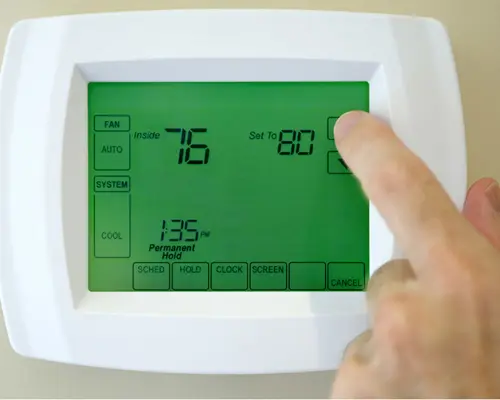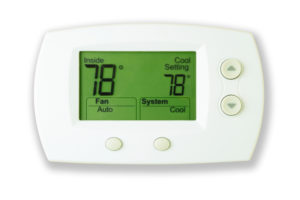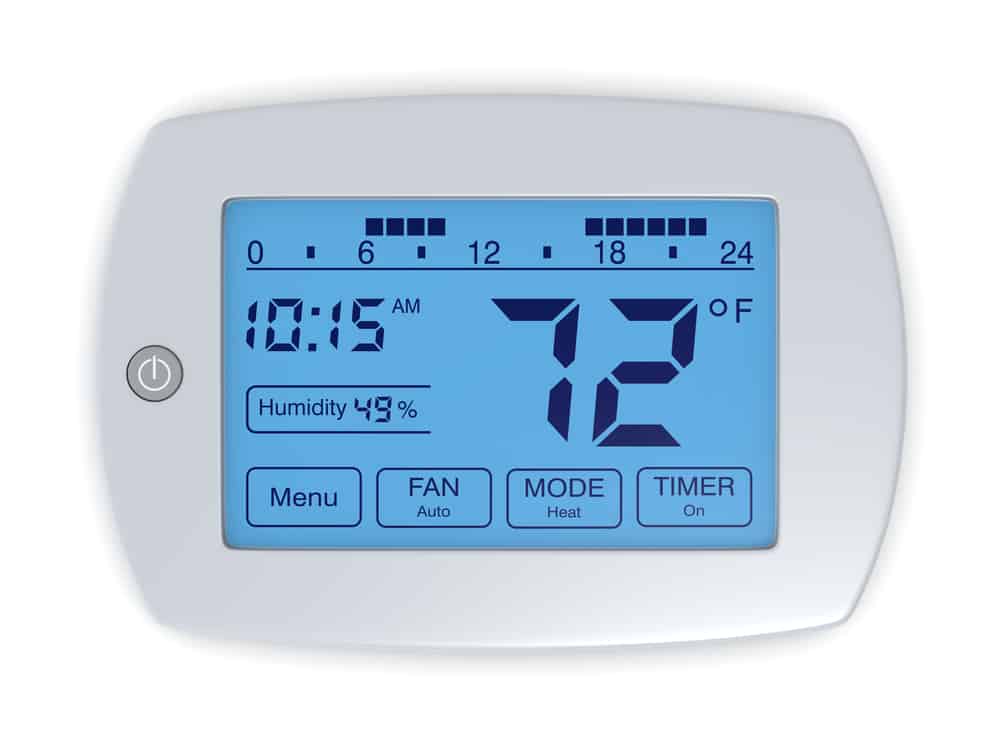Fan Auto on a thermostat controls the fan operation. It decides when the fan should run.
Understanding how Fan Auto works can save energy and improve comfort. This setting controls your HVAC system’s fan based on heating or cooling needs. When set to Auto, the fan runs only during heating or cooling cycles. This helps maintain a consistent temperature.
It also reduces energy use, as the fan isn’t running constantly. But what does this mean for your home? And why might you choose Auto over On? In this blog post, we’ll explore what Fan Auto means, how it works, and its benefits. We’ll help you understand why this setting can be a smart choice for managing your home’s climate control.

Credit: www.ars.com
Introduction To Thermostat Settings
Understanding your thermostat settings can significantly impact your home’s comfort. It can also affect energy efficiency and your utility bills. The ‘Fan Auto’ setting is one of the many options on modern thermostats.
Importance Of Thermostat Settings
Thermostat settings are crucial for maintaining indoor climate. They help regulate the temperature, ensuring comfort throughout the year. Proper settings can also lead to energy savings. By optimizing your thermostat, you can reduce unnecessary energy consumption.
Basics Of Hvac Systems
HVAC stands for Heating, Ventilation, and Air Conditioning. It is the system that controls the climate in your home. The thermostat is the control panel for the HVAC system. It allows you to set and maintain your desired temperature. Understanding the HVAC basics can help you make better use of your thermostat.

Credit: www.climatecare.com
Fan Auto Setting Explained
The fan auto setting on a thermostat is a feature many people find confusing. It plays a crucial role in managing your home’s HVAC system. Understanding this setting can help you optimize energy use and maintain comfort in your home.
Definition Of Fan Auto
In the fan auto setting, the thermostat controls the fan’s operation. The fan runs only when the heating or cooling system is actively conditioning the air. Once the desired temperature is reached, both the system and the fan turn off.
This means the fan doesn’t run continuously. Instead, it only operates during heating or cooling cycles. This helps save energy and reduces wear and tear on the fan motor.
How Fan Auto Works
When the thermostat is set to fan auto, it monitors the indoor temperature. If the temperature deviates from the set point, the HVAC system kicks in. The fan then circulates the conditioned air throughout the house.
Here’s a simple breakdown of how it works:
- The thermostat detects a change in temperature.
- The HVAC system turns on to heat or cool the air.
- The fan circulates the conditioned air.
- Once the set temperature is reached, the system and fan turn off.
This cycle repeats whenever the indoor temperature changes. The fan auto setting ensures efficient operation by running the fan only when necessary. This results in lower energy consumption and cost savings.
Fan Auto Vs. Fan On
Understanding the settings of your thermostat can help you manage your home’s comfort and energy use. Two common settings are “Fan Auto” and “Fan On.” Knowing the difference can save energy and improve air quality.
Differences Between Settings
The “Fan Auto” setting means the fan only runs during heating or cooling cycles. It will turn off once the desired temperature is reached. The “Fan On” setting keeps the fan running continuously, regardless of heating or cooling cycles.
Pros And Cons
Each setting has its benefits and drawbacks. The “Fan Auto” setting can save energy because it only runs when necessary. This can lower your electric bill. It also reduces wear on the fan, potentially extending its life.
On the downside, the “Fan Auto” setting might lead to uneven temperatures. Rooms far from the thermostat may feel warmer or cooler. The “Fan On” setting ensures even air distribution, improving comfort in all rooms. It can also help with air filtration, improving indoor air quality.
However, running the fan continuously uses more energy. This can increase your electric bill. It may also lead to more wear on the fan, reducing its lifespan.

Credit: airetechac.com
Benefits Of Using Fan Auto
Using the Fan Auto setting on your thermostat can offer numerous benefits for homeowners. This feature allows the fan to operate only when heating or cooling is needed, providing advantages like energy efficiency and cost savings. Understanding these benefits can help you make the best use of your thermostat settings.
Energy Efficiency
The Fan Auto setting can significantly improve your home’s energy efficiency. When the fan runs only during heating or cooling cycles, it reduces unnecessary energy use. This targeted operation ensures your HVAC system uses energy only when needed, minimizing waste.
Fan Auto also helps maintain a consistent temperature, which can enhance the overall efficiency of your heating and cooling system. By not running continuously, the fan reduces wear and tear, extending the life of your HVAC equipment.
Cost Savings
Utilizing the Fan Auto setting can lead to noticeable cost savings on your energy bills. Since the fan operates less frequently, it consumes less electricity. This reduction in energy use translates to lower monthly utility costs.
To illustrate the potential savings:
| Fan Setting | Estimated Monthly Cost |
|---|---|
| Fan Auto | $10 |
| Fan On | $20 |
As shown in the table, using Fan Auto can halve your monthly fan operation costs. Over a year, this adds up to significant savings, making Fan Auto a smart choice for budget-conscious homeowners.
Improving Hvac Efficiency With Fan Auto
Understanding your thermostat settings can greatly improve HVAC efficiency. One useful setting is the “Fan Auto” mode. This setting adjusts the fan operation based on temperature needs. Using Fan Auto can optimize your system’s performance and reduce wear and tear on components.
Optimizing System Performance
Fan Auto mode helps maintain a consistent indoor temperature. The fan runs only when heating or cooling is needed. This reduces energy consumption. It also ensures your HVAC system works efficiently. Your home stays comfortable without overworking the system.
Reducing Wear And Tear
Frequent use of the fan can lead to wear and tear. Fan Auto mode limits fan operation. The fan runs only when necessary. This reduces strain on the system. Components last longer. Maintenance costs go down. Your HVAC system stays reliable for a longer period.
Common Misconceptions
Understanding what the Fan Auto setting means on a thermostat can sometimes be confusing. Many people hold misconceptions about its purpose and functionality. Let’s debunk some common myths and clarify false beliefs about the Fan Auto setting.
Myths About Fan Auto
Many people believe that the Fan Auto setting is always the best choice. This is not entirely true. While it does have advantages, it’s not suitable for every situation. Here are some common myths:
- Myth 1: Fan Auto saves the most energy.
- Myth 2: Fan Auto provides the best air quality.
- Myth 3: Fan Auto always maintains a consistent temperature.
Each of these beliefs has some truth but also significant exceptions.
Clarifying False Beliefs
Let’s clarify these misconceptions one by one.
| Myth | Reality |
|---|---|
| Fan Auto saves the most energy | The fan runs only when heating or cooling. This can save energy but not always. |
| Fan Auto provides the best air quality | Constant fan operation (Fan On) can improve air circulation and quality. |
| Fan Auto maintains a consistent temperature | Fan Auto can lead to uneven temperature distribution in large homes. |
Understanding these points helps you make informed decisions about using the Fan Auto setting. Remember, the best choice depends on your specific needs and home environment.
When To Use Fan Auto
The ‘Fan Auto’ setting on your thermostat can optimize your HVAC system. It automatically controls the fan based on the temperature in your home. Knowing when to use the ‘Fan Auto’ setting can enhance comfort and energy efficiency. Let’s explore the best times to use this setting.
Ideal Scenarios
Use the ‘Fan Auto’ setting during normal weather conditions. The thermostat will manage the fan based on your heating or cooling needs. This ensures the fan only runs when necessary. It helps save energy and reduce wear on your HVAC system. Another ideal scenario is when you want quiet operation. The ‘Fan Auto’ setting minimizes fan noise by running it less frequently.
Seasonal Considerations
In summer, the ‘Fan Auto’ setting can help maintain cool air. It runs the fan only when the air conditioner is on. This helps keep the home cool without overworking the system. In winter, ‘Fan Auto’ ensures warm air circulates efficiently. The fan operates in sync with the furnace to provide consistent heating. This helps maintain a comfortable indoor temperature.
Troubleshooting Fan Auto Issues
Understanding the Fan Auto setting on your thermostat can save you energy and money. But what happens if it doesn’t work correctly? Let’s dive into some common problems and how you can fix them yourself.
Common Problems
Several issues can cause your thermostat’s Fan Auto setting to malfunction. Here are a few common ones:
- Fan runs continuously: This could be due to a stuck relay or a faulty thermostat.
- Fan doesn’t run at all: The issue might be with the fan motor or a blown fuse.
- Fan cycles on and off frequently: This can indicate a problem with the thermostat’s wiring.
Diy Solutions
You can try some simple solutions before calling a professional. Here are a few:
- Check the thermostat settings: Ensure the thermostat is set to Auto, not On.
- Inspect the wiring: Turn off the power and check for loose or damaged wires.
- Replace the thermostat batteries: Low batteries can cause malfunctioning.
- Reset the thermostat: Sometimes, a simple reset can resolve the issue.
If these steps don’t fix the problem, it might be time to call a professional. They can diagnose and repair more complex issues.
Frequently Asked Questions
What Does ‘fan Auto’ Mean On A Thermostat?
‘Fan Auto’ means the fan runs only when heating or cooling is needed. It saves energy.
How Is ‘fan Auto’ Different From ‘fan On’?
‘Fan Auto’ runs only when needed. ‘Fan On’ runs the fan continuously, even when not heating or cooling.
Does ‘fan Auto’ Save Energy?
Yes, ‘Fan Auto’ saves energy. The fan runs only when the system heats or cools.
Should I Use ‘fan Auto’ In Summer?
Yes, ‘Fan Auto’ is good for summer. It helps maintain a comfortable temperature and saves energy.
Can ‘fan Auto’ Improve Air Quality?
Yes, ‘Fan Auto’ can improve air quality. It filters air only when the system operates, reducing energy use.
Conclusion
Understanding the “Fan Auto” setting on your thermostat is essential. It helps manage your home’s comfort and energy use. Choosing the right fan setting can impact your energy bills and system efficiency. Experiment with both “Auto” and “On” to see what works best.
Remember, regular maintenance keeps your HVAC system running smoothly. Stay informed and keep your home comfortable year-round. Thank you for reading!
